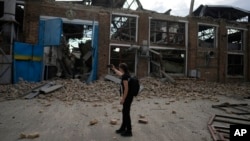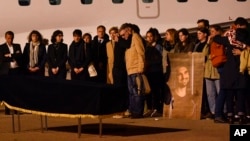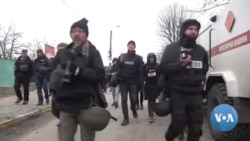Regulations from Ukraine covering media access to the front lines of the war have drawn criticism from reporters and media advocates who say the rules are not proportionate with the dangers for war correspondents.
Two of Ukraine’s operational commands, in the country’s east and south, released new rules in March governing how media can operate in areas under their control.
The rules bar journalists from working in “red zones” deemed the most dangerous and require a military press officer’s escort to work in less dangerous “yellow zones.”
Journalists can work freely in "green zones." And commanders will have discretion to allow reporters access to red zones in certain circumstances, according to local media.
Restrictions 'worrying'
But media watchdogs have said that the new regulations mean journalists are now denied access to over 50 municipalities in Ukraine.
“It’s worrying that such a decision can be made to restrict the access of journalists,” said Jeanne Cavelier, the Eastern Europe expert for media watchdog Reporters Without Borders, or RSF. “It’s in [Ukraine’s] interest” to facilitate reporting on the war.
At least one command later removed the order from its website, Cavelier told VOA.
Officials are advising journalists to connect with press officers directly when planning an assignment “to know in which color it is, if they’re allowed [access] or not,” said Cavelier.
The order is part of amendments to regulations under martial law governing how journalists can work.
All military commanders are now required to classify the territories under their control into separate zones.
Ukraine’s Washington embassy did not reply to VOA’s email requesting comment.
VOA emailed the Ukraine Ministry of Defense on Friday to ask whether the rules are now being enforced, and for its response to media concerns. At publishing time for this article, VOA had not received a response.
A Ministry of Defense statement provided to the advocacy group the Committee to Protect Journalists said, however, that the rules are meant “to improve interaction with representatives of the mass media while working in combat areas.”
Media risks
Russia’s invasion of Ukraine has made the country one of the deadliest for journalists. More than a dozen local and foreign correspondents have been killed there in the past year while on assignment.
The war also attracted large numbers of freelance journalists, many of whom were unfamiliar with working in conflict zones.
“The thing about war is the situation can change day to day and even hour to hour,” said Clothilde Redfern, director of the Rory Peck Trust, an organization that supports freelance journalists.
“The situation in Ukraine is changing all the time, and up-to-date, accurate in-country information is crucial for journalists’ safety,” she said.
Other media experts told VOA they thought the restrictions were excessive and not commensurate with the risks for journalists.
Sergiy Tomilenko, president of the National Union of Journalists of Ukraine, told VOA that "the new rules of military accreditation should not completely stop coverage of this war." He added that areas should be considered red zones only if reporting is impossible there because of the conflict.
Skepticism on safety
Oksana Romaniuk, the head of the Institute of Mass Information, a local press freedom group, said the restrictions appeared to be about safety, but she said she thought they were more about control.
“We do not think that it is connected with the desire to make the work of journalists safer. It is, rather, connected with the desire to make everything work like the army,” she told VOA from Kyiv.
Romaniuk said she thought Ukraine’s north and west operational commands had developed similar rules but had not yet published them because of the criticism of the other commands’ policies.
“They’re too rigid,” Karol Luczka said of the rules. Luczka, who focuses on Ukraine for the International Press Institute, a media rights organization, said, “There shouldn’t be a pre-established list of places which are excluded to journalists.”
“Access should really only be based on the situation on the ground,” on an ad hoc basis, Luczka said.
Cavelier, of RSF, said it’s important that the Ukrainian government balance journalist safety with the freedom to report. “We understand that some parts of the front line — very hot areas — are forbidden for journalists,” she said, but that doesn’t mean journalists should be barred entirely.
Details on the new regulations have also been unclear, analysts said, with zone lists on some fronts incomplete. This has added to the confusion and frustration, Cavelier said.
Military escorts — which Ukraine’s Institute of Mass Information said are in short supply — are also supposed to escort reporters in yellow zones, but some journalists already live and work in yellow zones full time. That has led to questions about how a journalist based in one of those areas is supposed to operate.
Alongside the war on the ground in Ukraine is a battleground on the internet, with disinformation pushed out in an effort to influence opinion.
“Journalists in Ukraine are crucial to countering Russian disinformation,” said IPI’s Luczka. “In order to ensure that the world continues to trust Ukraine in terms of what is going on on the front lines, journalists need to be present.”
The ultimate consequence, said Romaniuk, is that some stories may never be told.
Reporting that, for the past year, has documented crimes and informed people about the plight of Ukraine’s people will now be harder to achieve.
“For us, it is extremely important to tell the world, because people are dying every day,” Romaniuk said. “It is the only thing that gives us hope and gives us strength and resilience.”












